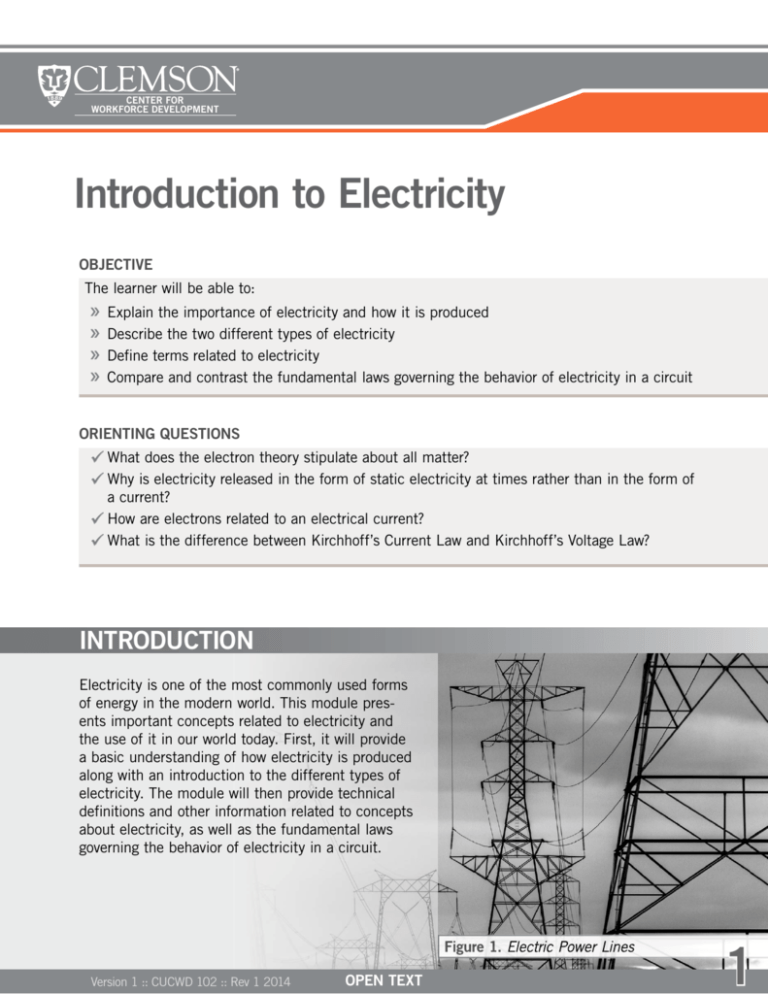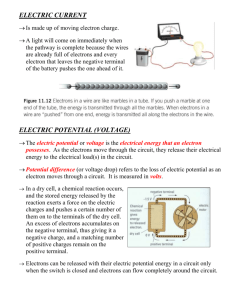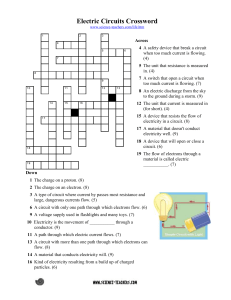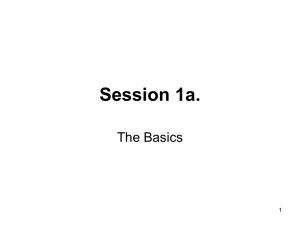
CENTER FOR
WORKFORCE DEVELOPMENT
Introduction to Electricity
OBJECTIVE
The learner will be able to:
»
»
»
»
Explain the importance of electricity and how it is produced
Describe the two different types of electricity
Define terms related to electricity
Compare and contrast the fundamental laws governing the behavior of electricity in a circuit
ORIENTING QUESTIONS
ü What does the electron theory stipulate about all matter?
ü Why is electricity released in the form of static electricity at times rather than in the form of
a current?
ü How are electrons related to an electrical current?
ü What is the difference between Kirchhoff’s Current Law and Kirchhoff’s Voltage Law?
INTRODUCTION
Electricity is one of the most commonly used forms
of energy in the modern world. This module presents important concepts related to electricity and
the use of it in our world today. First, it will provide
a basic understanding of how electricity is produced
along with an introduction to the different types of
electricity. The module will then provide technical
definitions and other information related to concepts
about electricity, as well as the fundamental laws
governing the behavior of electricity in a circuit.
Figure 1. Electric Power Lines
Version 1 :: CUCWD 102 :: Rev 1 2014
OPEN TEXT
1
CENTER FOR
WORKFORCE DEVELOPMENT
1 Fundamentals of Electricity
Electricity is the energy resulting from the movement
of charged particles. An understanding of the Electron
Theory provides insight into the electrical properties
of substances. This theory stipulates that all matter is
made up of molecules, which are made up of atoms,
and that each atom is a combination of electrons, protons, and neutrons.
Matter can be defined as a material that has measurable mass and occupies space. This terminology incorporates substances in all states including liquid, solid,
and gas. Scientists did not describe matter in terms of
atoms until the beginning of the twentieth century.
Matter is made up of molecules.
A molecule is the smallest unit of matter that can be
physically displayed and take part in a chemical reaction. The movement of molecules is related to the
temperature of the matter. Molecules become more
agitated as the temperature goes higher. Molecules
are made up of atoms. A water molecule is shown in
Figure 2.
Figure 2. Water Molecule in 3D
An atom is the basic unit of a molecule and is the
smallest entity of matter. Atoms carry the chemical and
physical properties of that matter. Atoms consist of a
nucleus and electrons which gravitate around the nucleus.
The nucleus of an atom is typically made of positively charged protons and electrically neutral
neutrons. The electrons are negatively charged and normally in equal proportion to the protons
in the atom, which makes the atom neutral.
Activity 1.1
»
2
The Electron Theory stipulates that all matter is made up of molecules, which are made up
of atoms, and that each atom is a combination of electrons, protons, and neutrons. Define
the following terms: molecule, atom, and electron.
Version 1 :: CUCWD 102 :: Rev 1 2014
OPEN TEXT
CENTER FOR
WORKFORCE DEVELOPMENT
2 Electron Flow
Atoms from some substances release one or more
electrons when placed in contact with other materials.
This movement of electrons from one atom to the next
is called electron flow and often results in electricity.
Electricity can either flow as a current or be released in
the form of static electricity, depending on the availability of an escape route for the electron flow.
Static electricity is an electric charge trapped on a surface that is usually created by the friction between two
surfaces that are highly resistant to electrical current.
Static electricity can be created in a variety of ways. For instance, it can be produced by applying mechanical stress to certain crystals or ceramics through heat. It can also be produced by
bringing an electronically charged object close to a neutral one.
The two notations for electrical flow are conventional flow and electron flow. These two types of
flow both describe the movement of electrical charges through a circuit with electricity flowing
from a point carrying a surplus charge to another point with a deficiency in charge.
With a conventional flow notation, a technician
considers the point of origin of electron flow as
positive because it carries a surplus charge. The
receiving end for the electron flow is described
as negative because it is deficient in electrical
charge. Conventional flow is represented by the
red line in Figure 3.
Figure 3. Current notation
An electron flow notation, represented by the
green line in Figure 3, is a description of the
actual movement of electrons from the point in
a circuit with a surplus of electrons (the negative
side) to the point in the circuit that is deficient in
electrons (the positive side).
Activity 2.1
»
Figure 3. Current Notation Differentiate between conventional flow and electron flow, the two notations for electrical flow.
Version 1 :: CUCWD 102 :: Rev 1 2014
OPEN TEXT
3
CENTER FOR
WORKFORCE DEVELOPMENT
3 Definitions of Terms Related to Electricity
The following terms related to electricity are explained in this
section: voltage, magnetic field, electron, current, resistance,
conductor, insulator, and semiconductor.
Voltage is the difference in the electrical charge between two
points that can push electrical current between the points.
Voltage is also known as electrical pressure. When voltage
is high between two points, it is possible to obtain a high
electrical flow.
Voltage can be created by the:
»
»
Use of chemicals (example is car battery)
»
Use of heat or light (example is solar cell).
Use of a magnetic field (an area of force around an object that happens due to changing
electric fields created by the movement of electrical charges)
Regardless of the method used, voltage occurs only when a negatively charged item is in the
presence of a positively charged item. Voltage is measured in volts.
An electron is an elementary particle that is negatively charged. A current is the movement of
electrons resulting from a difference in voltage, or pushing force. A current is also known as a
flow of charge and a closed circuit is usually required. Electrons tend to flow from a point of
lower potential charge to a point of higher potential charge because they are negatively
charged. Current is a measurement of the number of electrons that go through a specific point
in the circuit in a second. This measurement is expressed in ampere or amps and the symbol
is “A”. Current flows from negative to positive outside of the power source, but it flows from
positive to negative inside the source.
All materials have some opposition to the
flow of current due to the friction created
by the movement of electrons. This opposition is called resistance and is measured
in ohms (Ω). The symbols that represent
resistance are the three jagged lines in
the diagram shown in Figure 4.
4
Figure 4. Resistance in Electricity
The wires carrying current from the source
to another point in the circuit will also
have some resistance. This resistance will
vary proportionally with the length of the wire and inversely with the diameter of the wire and
the larger the surface area, the less the resistance will be. The composition of the material and
the temperature can also affect resistance.
Version 1 :: CUCWD 102 :: Rev 1 2014
OPEN TEXT
CENTER FOR
WORKFORCE DEVELOPMENT
A bridge is a two-branch circuit that reaches
balance when the difference in the potential charge
between a point in one branch and the same point
in the other branch is null. The Wheatstone Bridge
was created in the early ninetieth century and
this type of circuit is used to measure unknown
resistance. It consists of four resistances, one of
which is the unknown, interconnected in a specific
fashion.
Figure 5. Wheatstone Bridge
An example of this type of circuit is shown
in Figure 5. If R1, R2, and R3 are the known
resistances used in the bridge, Rx represents the
unknown resistance. G is the galvanometer and
it indicates the voltage across the branches. The bridge will be in a state of balance only if the
value displayed by V is null. In accordance with the balance principle of bridges, the ratios of
R2 with R1 (R2 /R1) and Rx with R3 (Rx / R3) will only be equal when G points to zero.
A conductor is a substance or object with the intrinsic ability to carry electric current. The
atomic structure of a substance is a good way to recognize the associated electrical properties.
For instance, some materials have loosely bound electrons that are called free electrons. A
material with loosely bound electrons is a fairly good conductor of electricity and conduction
capabilities increase when the number of free electrons in a substance increases. All
conductors offer some resistance to electrical current regardless of the associated electron
count.
An insulator is a material or substance such as glass that has a minimal number of free
electrons, thus causing resistance to the current flow. Typically, chemical compounds that are
made of different chemical elements are insulators. Examples of insulators are Teflon, polyvinyl chloride (PVC), mica, quartz and glass.
A semiconductor cannot be classified as either a conductor or insulator because it has exactly
four electrons in the outer sphere. Semiconductors allow current flow only in one direction.
However, for semiconductors to allow current flow, they should be connected in the same
direction as the flow. A diode is an example of semiconductor.
Activity 3.1
»
Explain the following terms that are related to electricity: voltage, magnetic field, electron,
current, resistance, conductor, insulator, and semiconductor.
Version 1 :: CUCWD 102 :: Rev 1 2014
OPEN TEXT
5
CENTER FOR
WORKFORCE DEVELOPMENT
4
Ohm’s Law and Kirchhoff’s Laws
Voltage, current, and resistance are all tied together by a simple equation: Voltage = Current *
Resistance (V= I * R) which is called Ohm’s Law. George Simon Ohm, a German physicist,
established this law and the underlying principle. This equation and other derivatives have
simplified the understanding of electrical concepts. One example of a concept that is easier to
understand based on Ohm’s Law is that high voltage applied across a material with a small
resistance will lead to a strong current. This law also implies that neither voltage nor current
can produce an isolated change. For example, if the resistance in a circuit is kept constant, a
change in voltage will result in a similar change in current and vice-versa. On the other hand, a
change in a circuit’s resistance will result in an inverse change in the current for the same
voltage. It is important to note that the application of this law and the associated conclusions
are valid only with consistent temperature conditions.
Gustav Kirchhoff established two equations dealing with
the conservation of charge and energy in electrical circuits. These two equations are called Kirchhoff’s Current
Law and Kirchhoff’s Voltage Law. Based on Kirchhoff’s
Current Law (KCL), the sum of the current flowing in is
equal to the sum of the current flowing out at any given
junction in an electrical circuit. KCL is also known as the
First Law and is shown in Figure 6.
Figure 6. Kirchhoff’s Current Law (KCL)
Kirchhoff’s Voltage Law (KVL) is also an equality equation, but it deals with energy. Based on KVL, the directed sum of voltages around any closed circuit is null. In
7. Kirchhoff’s Voltage Law (KVL)
other words, the difference of potential charge between Figure
two points in a closed circuit is the same regardless of
the path chosen. For example, in Figure 7, the voltage
between the points “a” and “d” is equal to the generated V4 and also to the sum (V1 + V2 +V3). KVL is also
known as the Second Law.
Activity 4.1
»
6
Figure 7. Kirchhoff’s Voltage Law Compare and contrast Ohm’s Law, Kirchhoff’s Current Law, and Kirchhoff’s Voltage Law.
Version 1 :: CUCWD 102 :: Rev 1 2014
OPEN TEXT
CENTER FOR
WORKFORCE DEVELOPMENT
SUMMARY
Key Concepts
»
»
Electricity is one of the most commonly used forms of energy in the modern world.
»
The two notations used to describe the current flow are the conventional flow and the
electron flow.
»
»
Voltage is a type of pressure which pushes electrons to flow through a material.
»
A conductor is a substance or object with the intrinsic ability to carry electric current
whereas an insulator has very high resistance and does not carry an electric current. A
semiconductor can conduct electricity, but only in one direction.
»
The discoveries of the fundamental laws that govern the behavior of electricity have
helped to simplify understanding of electrical concepts.
The Electron Theory stipulates that all matter is composed of molecules that are composed of atoms, which in turn are made up of electrons, neutrons and protons.
A current is the movement of electrons resulting from a difference in voltage between two
points. Current is a measurement of the number of electrons that go through a specific
point in the circuit in a second.
Key Terms
1
2
Electricity pg.2
3
Voltage pg.4
Insulator pg.5
Matter pg.2
Magnetic Field pg.4
Semiconductor pg.5
Molecule pg.2
Electron pg.4
Atom pg.2
Current pg.4
Nucleus pg.2
Resistance pg.4
Electron Flow pg.3
Wheatstone Bridge pg.5
Static Electricity pg.3
Conductor pg.5
4
Ohm’s Law pg.6
Kirchhoff’s Current Law (KCL)
pg.6
Kirchhoff’s Voltage Law (KVL)
pg.6
Further Study
Books:
1. Gibilisco, S., & NetLibrary, I. (2002). Teach Yourself Electricity and Electronics. New York:
McGraw-Hill.
2. Thompson, Lawrence M. (2006). Basic Electricity and Electronics for Control -
Fundamentals and Applications (3rd Edition). ISA. (http://www.knovel.com/web/portal/
browse/display?_EXT_KNOVEL_DISPLAY_bookid=1816&VerticalID=0)
Online:
http://www.rare-earth-magnets.com/t-conventional-vs-electron-flow.aspx
Version 1 :: CUCWD 102 :: Rev 1 2014
OPEN TEXT
7
CENTER FOR
WORKFORCE DEVELOPMENT
GLOSSARY
» Atom: basic unit of a molecule and smallest entity of matter carrying the chemical and physical properties of that matter
» Conductor: substance or object with the intrinsic ability to carry electric current
» Current: flow of electrical charges
» Electricity: energy resulting from the movement of charged particles
» Electron: elementary particle that is negatively charged
» Electron flow: movement of electrons from one atom to the next
» Insulator: Object or matter with atomic structure that does not allow it to carry an electric
current
» Kirchhoff’s Current Law: based on this law, the sum of the current flowing in is equal to the
sum of the current flowing out at any given junction in an electrical circuit
» Kirchhoff’s Voltage Law: based on this law, the directed sum of voltages around any closed
circuit is null; in other words, the difference of potential charge between two points in a closed
circuit is the same regardless of the path chosen
» Magnetic field: area of force around an object that happens due to changing electric fields
created by the movement of electrical charges
» Matter: physical substance that occupies space
» Molecule: smallest physical entity of matter
» Nucleus: part of the structure of the atom that is composed of protons that are positively
charged and neutrons that have no electrical charge
» Ohm’s Law: mathematical law that describes the relationship between the current flowing
through an object, the resistance, and the voltage at the terminal or terminals of the object
» Resistance: opposition to current found in an object or portion of circuit
» Semiconductor: object that can only carry electric current under specific conditions
» Static electricity: happens due to an accumulation of charges on an insulator and is the only
form of electricity in which motion is irrelevant
» Voltage: electrical pressure that pushes electrons to move across matter and is the difference
of electrical potential between two points
» Wheatstone bridge: Circuit used to determine the value of an unknown resistance
8
This material is based upon work supported by the National Science Foundation
under Grant Number DUE-1104181. Any opinions, findings, and conclusions or
recommendations expressed in this material are those of the author(s) and do
not necessarily reflect the views of the National Science Foundation.
Copyright © 2013 Clemson University Center for Workforce Development. All Rights Reserved.
Version 1 :: CUCWD 102 :: Rev 1 2014
OPEN TEXT
CENTER FOR
WORKFORCE DEVELOPMENT
Attribution Tables
Author/s
Title
Angelo
DeSantis
Power lines
Eric Skiff
Hand-cranked
generator
Chemitorium Water Molecule in 3D
Ingo Hoffman
Static Electrticity
Flekstro
Current Notation
CORE-Matreials Zn-Mg-Ho Diffraction
Pasquale.
Carelli
Resistance in
Electricity
PACO
Wheatstone Bridge
Phatency
Omegatron
Kirchhoff's Current
Law
Kirchhoff’s Voltage
Law
Microsoft
Clipart
City at night (PPT
Lecture 2)
Rhys A.
Danger: High voltage
(PPT Lecture 2)
Windell Oskay Magnetic Fields -15
Windell Oskay
Diodes
Version 1 :: CUCWD 102 :: Rev 1 2014
Source
http://www.flickr.com/photos/78023771@
N00/8618709561/
http://www.flickr.com/photos/
ericskiff/3864436065/
http://commons.wikimedia.org/wiki/
File:Water_Molecule_3D_X_3.jpg
http://www.flickr.com/photos/
la_sombra/6036168427/
http://commons.wikimedia.org/w/index.
php?title=File:Current_notation.svg&page=1
http://www.flickr.com/photos/
core-materials/6214110513/
http://commons.wikimedia.org/wiki/
File:3Resistance.png#filelinks
http://commons.wikimedia.org/wiki/
File:PWheatstone.png
http://commons.wikimedia.org/wiki/
File:Kirchhoff%27s_first_law_example.png
http://commons.wikimedia.org/wiki/File:KVL.
png#filehistory
http://office.microsoft.com/en-us/
images/results.aspx?qu=city&ex=1#ai:
MP900448397|
http://www.flickr.com/photos/
rhysasplundh/4807749216/
http://www.flickr.com/photos/
oskay/4581194252/
http://www.flickr.com/photos/17425845@
N00/437341293/
OPEN TEXT
License
CC-BY-2.0
CC-BY-SA-2.0
Public domain
CC-BY-2.0
CC-BY-SA 3.0
CC-BY-SA-2.0
Public domain
CC-BY-SA 3.0
CC-BY-SA 3.0
CC-BY-SA 3.0
With permission
from Microsoft
CC-BY-2.0
CC-BY-2.0
CC-BY-2.0
9








